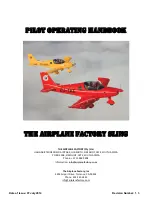
MALFUNCTION DETECTION.
The detection of system malfunction largely depends on the mechanic's ability to interpret the gauge pressure
readings into system problems. A system operating normally will have a low side gauge pressure reading that
will correspond with the temperature of the refrigerant evaporating in the evaporator, allowing for a few degrees
temperature rise due to loss in the tube walls and fins. The high side will have a gauge pressure that will
correspond with the temperature of the refrigerant condensing in the condenser, allowing for a few degrees
temperature drop due to loss in the tube walls and fins.
Any deviation from that which is normal indicates a malfunction within the system due to a faulty control
device. obstruction, defective part, or improper installation.
Detection of system malfunction is made easier with the knowledge that the temperature and pressure of
Refrigerant 12 is in close proximity between the pressures of twenty and eighty pounds per square inch (psi). A
glance at the temperature pressure chart will show that there is only a slight variation between the temperature
and pressure of the refrigerant in the lower range.
It is correct to assume that for every pound of pressure added to the low side, a temperature increase of about
one degree Fahrenheit takes place. For instance, a pressure of 23.8 on the chart indicates a temperature of 24°F.
A change of pressure of almost one pound to 24.6 psi gives us a temperature increase to 25°F.
— Note —
For each 1,000 feet of elevation above sea level, the gauge readings will be about one
inch of mercury or 1/2 psi higher than the chart indicates.
It must be pointed out that the actual temperature of the air passing over the coils of the evaporator will be
several degrees warmer allowing for a temperature rise caused by the loss in the fins and tubing of the evaporator.
The importance of a seasonal check up of the air conditioning system should be brought to the attention of the
customer whenever possible. A thorough check of the system performed in a methodical manner will reveal
trouble the customer is often not aware of. Locating and repairing the trouble early will usually result in savings
to the customer both in time and additional troubles that too often result from neglect.
A Performance Test of the system is the only positive way in which the complete system can be checked for
efficient operation. The air conditioning system should be given this test before work is begun on the system,
whenever possible, however, if the system is completely inoperative, repairs must be performed before the system
can be properly tested. The test can uncover further work that must be performed before the system is brought to
its full operating efficiency. The Performance Test should always be performed after repair work has been done
and before the aircraft is released to the customer. The serviceman performing this test carefully will insure that
the repairs have been properly performed and that the system will operate satisfactorily.
The Performance Test when properly performed includes a thorough examination of the outside of the system
as well as the inside. Many related parts are overlooked because it is felt they are of no bearing on the operating
efficiency of the unit. For this reason, a thorough visual inspection of the complete system should be performed,
followed by an operating inspection of the system.
PA - 4 4 - 1 8 0 / 1 8 0 T
AIRPLANE MAINTENANCE MANUAL
2 1 - 5 1 - 0 3
Page 21-56
Revised: May 15, 1989
1G23
PIPER AIRCRAFT
Summary of Contents for SEMINOLE PA-44-180
Page 38: ...CHAPTER DIMENSIONS AND AREAS 1B14...
Page 49: ...CHAPTER LIFTING AND SHORING 1C1...
Page 53: ...CHAPTER LEVELING AND WEIGHING 1C5...
Page 58: ...CHAPTER TOWING AND TAXIING 1C10...
Page 62: ...CHAPTER PARKING AND MOORING 1C14...
Page 65: ...CHAPTER REQUIRED PLACARDS 1C17...
Page 70: ...CHAPTER SERVICING 1C22...
Page 98: ...CHAPTER STANDARD PRACTICES AIRFRAME 1E2...
Page 108: ...CHAPTER ENVIRONMENTAL SYSTEM 1E12...
Page 189: ...CHAPTER AUTOFLIGHT 1H21...
Page 192: ...CHAPTER COMMUNICATIONS 1H24...
Page 202: ...CHAPTER ELECTRICAL POWER 1I10...
Page 228: ...CHAPTER EQUIPMENT FURNISHINGS 1J12...
Page 233: ...CHAPTER FIRE PROTECTION 1J17...
Page 238: ...CHAPTER FLIGHT CONTROLS 1J24...
Page 304: ...2A18 CHAPTER FUEL...
Page 325: ...2B17 CHAPTER HYDRAULIC POWER...
Page 357: ...2D1 CHAPTER ICE AND RAIN PROTECTION...
Page 414: ...CHAPTER LANDING GEAR 2F13...
Page 479: ...2I6 CHAPTER LIGHTS...
Page 488: ...2I16 CHAPTER NAVIGATION AND PITOT STATIC...
Page 503: ...2J7 CHAPTER OXYGEN...
Page 524: ...2K6 CHAPTER VACUUM...
Page 535: ...2K19 CHAPTER ELECTRICAL ELECTRONIC PANELS AND MULTIPURPOSE PARTS...
Page 546: ...INTENTIONALLY LEFT BLANK PA 44 180 180T AIRPLANE MAINTENANCE MANUAL 2L6 PIPER AIRCRAFT...
Page 547: ...2L7 CHAPTER STRUCTURES...
Page 582: ...CHAPTER DOORS 3A18...
Page 593: ...CHAPTER STABILIZERS 3B8...
Page 604: ...CHAPTER WINDOWS 3B22...
Page 611: ...CHAPTER WINGS 3C10...
Page 624: ...CHAPTER PROPELLER 3D1...
Page 643: ...CHAPTER POWER PLANT 3D21...
Page 667: ...CHAPTER ENGINE FUEL SYSTEM 3F1...
Page 681: ...CHAPTER IGNITION 3F16...
Page 712: ...CHAPTER ENGINE INDICATING 3H1...
Page 730: ...CHAPTER EXHAUST 3H19...
Page 734: ...CHAPTER OIL 3I1...
Page 743: ...CHAPTER STARTING 3I11...
Page 755: ...CHAPTER TURBINES 3J1...
















































